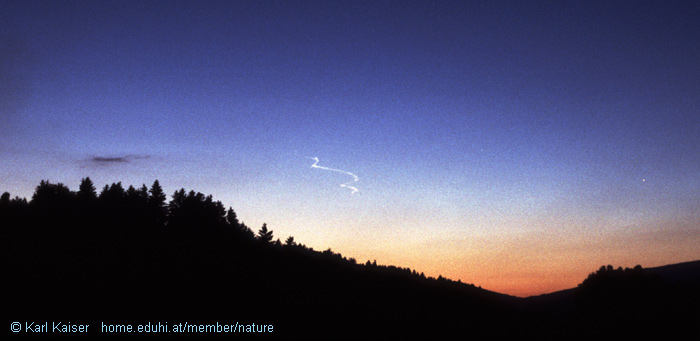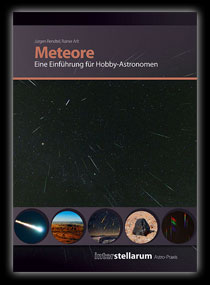
Feuerkugel vom 25. Juni 2004
Fireball over Germany – observed from Austriak.kaiser@eduhi.at
 |
Schlägl, knapp nach 20:25 UT: Wenige Minuten nach der Sichtung der Leuchtspur des Meteoriten zerzausten kräftige Höhenwinde die Linie zu Zacken und ersten Bögen. Capella, der Hauptstern des Sternbildes Fuhrmann steht in der Nähe des rechten Bildrandes.
Foto: © Karl Kaiser; f = 58 mm; 1:2,8; Kodak Elite 400.
Der Abend des 25. Juni 2004 war für die Beobachtung von Nachtleuchtenden Wolken bestens geeignet: wolkenloser Himmel mit hervorragender atmosphärischer Durchsicht bis zum Horizont! Bis 22:05 MESZ vermindert sich Ende Juni/Anfang Juli die Helligkeit in Nordösterreich so weit, dass Nachtleuchtende Wolken von Schlägl aus (48° 38´ N; 13° 58´ E) beobachtet werden können. Diesmal zeigte sich zwar keine der "begehrten" Wolken, dafür aber die Nachleuchtspur einer Feuerkugel mit einer von mir noch nie gesehenen Helligkeit! Im Augenblick des Eintretens des Meteoroiden blickte ich in Richtung Osten. Es war zwar kein Aufleuchten in der Landschaft zu bemerken, dafür war es an diesem Abend um etwa 22:23 MESZ noch zu hell, die wenige Augenblicke später im NNW beobachtete Leuchtspur hob sich aber in großer Intensität vom Dämmerungshimmel ab. Ihre Höhe überm Horizont lag im Bereich von 10°. Ein weiterer Zeuge des Meteoroideneintritts in die Lufthülle beschrieb die "Sternschnuppe" als einen sehr schnell von links nach rechts ziehenden grellen, gelblich weißen Lichtpunkt mit etwa 1/3 des Vollmonddurchmessers. Seinen Angaben nach beobachtete er den leuchtenden Körper etwa 1 s lang, bevor er hinter einem Waldstück verschwand. Der Beobachter und sein Sohn waren mit ihrem Auto ungefähr 6 km südöstlich von Schlägl unterwegs.
Die Nachleuchtspur des Meteoroiden leuchtete von der Sonne beschienen hellgelb auf, zunächst scharf wie ein Kondensstreifen; innerhalb weniger Minuten änderte sich aber sein Aussehen dramatisch: Eine zunächst zu beobachtende Zackung ging durch starke Höhenwinde beeinflusst rasch in Bögen über, schließlich bildeten sich Schleifen. Die linken und rechten Teile der Wolke drifteten rasch in Richtung Süden:
Ohne Feldstecher konnte ich die Erscheinung von etwa 22:23 bis 22:40 (!) MESZ verfolgen; mit dem Fernglas bot die filigran anmutende Wolke einen unvergesslich schönen Eindruck bis 22:45 MESZ. Zum Schluss leuchtete sie nur noch matt im Licht des Halbmondes.
Schätzungen nach könnte die Feuerkugel überm Thüringer Wald ihre Bahn gezogen haben. Ein Blick aufs Satellitenbild des Abends zeigte über weiten Teilen Deutschlands dichte Wolkenfelder. So ist es auch wenig verwunderlich, dass bis heute keine weiteren Beobachtungsberichte zum Boliden eingegangen sind. Wolkenfrei war es damals nur westlich der Linie Kassel-Stuttgart und südlich der Verbindung Stuttgart-Prag. Größere Wolkenlücken gab es nur mehr nördlich und nordöstlich von Kassel. Für Meteoritenortungskameras war wohl der Abend noch zu wenig weit fortgeschritten.
Sollten unter den geschätzten Lesern doch noch Augenzeugen dieser spektakulären Feuerkugel sein, bitte ich um Informationen an meine Mailadresse k.kaiser@eduhi.at. Danke!
| Ein lesenswertes Buch zum Thema: |  |
| Meteore - Eine Einführung für Hobbyastronomen |
Fireball over Germany – observed from Austria
 |
Foto: © Karl Kaiser; f = 58 mm; 1:2,8; Kodak Elite 400.
The evening of June 25th, 2004 seemed ideal for the observation of Noctilucent Clouds: a cloudless sky and perfect transparency to the horizon! At the end of June and beginning of July the brightness of the dawn diminishes till 20:05 UT so much that in Schlägl (northern part of Austria, 48° 38´ N; 13° 58´ E) NLC are sometimes visible. During this evening I could not see these wonderful clouds but an illuminated trail of a giant fireball with an extraordinary brightness. At the moment of the incoming of the meteoroid I looked to the eastern horizon. I did not watch a flash up because at 20:23 UT the dawn was still too bright. Some moments later I discovered the glaring trail at the height of 10° northnorthwest of my position. A friend of mine and his son also watched the fireball moving through the atmosphere for one second before it disappeared behind a forest. Their location was about 6 km southeast of Schlägl. He described it as a very fast moving yellow-white spot (roughly a third of our moon’s diameter) coming from the left side.First the trail of the meteor, lighted up by the sun, was comparable with a sharp bounded vapour trail of a jet; but within some minutes the shape changed dramatically from indentations to arcs and finally to big loops. This was a proof of strong winds in high layers of the earth’s atmosphere. Quickly the left and right parts of the cloud moved southward whereas the section in the middle stood still:
With the naked eye the trail of the meteor was visible from 20:23 till 20:40 (!) UT, with my field-glasses till 20:45 UT. At the end of the observation the cloud was shining dimly in the light of the half moon.
Maybe the fireball’s path crossed the Thuringia Forest in Germany. Satellite images of this evening show that most parts of our neighbouring country where covered with compact clouds. So it´s not astonishing that till this day (4th of July) no other reports of this great event are available. On June 25th only parts of Germany west of the line Kassel-Stuttgart and south of the line Stuttgart-Prague were cloudless and some bigger cloudless areas were located only north and northeast of Kassel. Automatically working meteor cameras had presumably not yet been started because of the bright dawn.
I am looking forward to getting eye-witness reports of this unique event. Please mail to my e-mail address: k.kaiser@eduhi.at Thank you!
© 2004 Karl Kaiser